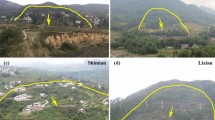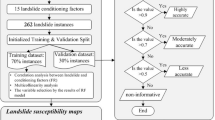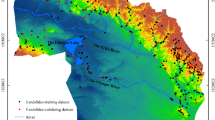Abstract
Landslide is one of the most common geological hazards, which causes a large number of property damage and loss of life in China every year. This case study was a 330-kV transmission line project located in Longnan City, Gansu Province, China, which is known as an area prone to landslides. A hybrid model of fractal theory-information value-random forests algorithm (FT-IV-RF) was proposed to evaluate the landslide susceptibility. First, sixteen landslide conditioning factors and pre-existing landslide events were selected as the initial evaluation indexes of landslide susceptibility from four datasets (geology, topography, climate and environment, and landslide inventory). Second, Pearson coefficient and sensitivity analyses were conducted to extract ten landslide conditioning factors with small correlation and large contribution to landslide occurrence from sixteen factors. Third, the weight of each class for a given factor were determined by using a combination of fractal theory and information value algorithms, which was regarded as one of input parameters and used to select the training samples in the random forest model. Four, k-means clustering was performed to classify the landslide susceptibility indices, which were predicted using the random forest model, into five levels to produce the landslide susceptibility map of the study area. Furthermore, the proposed model of FT-IV-RF model was validated by comparing with results obtained using information value (IV), back-propagation neural network (BPNN), and fuzzy logic (FL) models. Good agreements on the susceptibility estimation were observed among four models, and the hybrid model had the largest area under the curve (AUC) value of 0.996, indicating a good performance of the proposed hybrid model.












Similar content being viewed by others
Availability of data and material
The data and materials that support the findings of this study are available from the corresponding author, Yunfeng Ge, upon reasonable request.
Code availability
The codes that supports the findings of this study are available from the corresponding author, Yunfeng Ge, upon reasonable request.
References
Abedini M, Ghasemian B, Shirzadi A, Shahabi H, Chapi K, Pham BT, Tien Bui D (2019) A novel hybrid approach of bayesian logistic regression and its ensembles for landslide susceptibility assessment. Geocarto Int 34(13):1427–1457
Abuzied SM, Alrefaee HA (2019) Spatial prediction of landslide-susceptible zones in El-Qaá area, Egypt, using an integrated approach based on GIS statistical analysis. Bull Eng Geol Env 78(4):2169–2195
Abuzied SM, Pradhan B (2020) Hydro-geomorphic assessment of erosion intensity and sediment yield initiated debris-flow hazards at Wadi Dahab Watershed, Egypt. Georisk Assess Manage Risk Eng Syst Geohazards 1–26
Abuzied S, Ibrahim S, Kaiser M, Saleem T (2016) Geospatial susceptibility map** of earthquake-induced landslides in Nuweiba area, Gulf of Aqaba. Egypt J Mt Sci 13(7):1286–1303
Achour Y, Boumezbeur A, Hadji R, Chouabbi A, Cavaleiro V, Bendaoud EA (2017) Landslide susceptibility map** using analytic hierarchy process and information value methods along a highway road section in Constantine, Algeria. Arab J Geosci 10(8):194
Ahmed B (2015) Landslide susceptibility map** using multi-criteria evaluation techniques in Chittagong Metropolitan Area, Bangladesh. Landslides 12(6):1077–1095
Akgun A (2012) A comparison of landslide susceptibility maps produced by logistic regression, multi-criteria decision, and likelihood ratio methods: a case study at İzmir, Turkey. Landslides 9(1):93–106
Azarafza M, Ghazifard A, Akgün H, Asghari-Kaljahi E (2018) Landslide susceptibility assessment of South Pars Special Zone, southwest Iran. Environ Earth Sci 77(24):805
Bai S, Wang J, Zhang Z, Cheng C (2012) Combined landslide susceptibility map** after Wenchuan earthquake at the Zhouqu segment in the Bailongjiang Basin, China. CATENA 99:18–25
Belgiu M, Drăguţ L (2016) Random forest in remote sensing: a review of applications and future directions. ISPRS J Photogramm Remote Sens 114:24–31
Benesty J, Chen J, Huang Y (2008) On the importance of the Pearson correlation coefficient in noise reduction. IEEE Trans Audio Speech Lang Process 16(4):757–765
Breiman L (2001) Random forests. Mach Learn 45(1):5–32
Bui DT, Lofman O, Revhaug I, Dick O (2011) Landslide susceptibility analysis in the Hoa Binh province of Vietnam using statistical index and logistic regression. Nat Hazards 59(3):1413–1444
Bui DT, Tsangaratos P, Nguyen VT, Van Liem N, Trinh PT (2020) Comparing the prediction performance of a Deep Learning Neural Network model with conventional machine learning models in landslide susceptibility assessment. CATENA 188:104426
Cascini L (2008) Applicability of landslide susceptibility and hazard zoning at different scales. Eng Geol 102(3–4):164–177
Chao M, Ma X (2015) Convenient electrochemical determination of sunset yellow and tartrazine in foodsamples using a poly (L-phenylalanine)-modified glassy carbon electrode. Food Anal Methods 8(1):130–138
Che VB, Kervyn M, Suh CE, Fontijn K, Ernst GG, Del Marmol MA, Jacobs P (2012) Landslide susceptibility assessment in Limbe (SW Cameroon): a field calibrated seed cell and information value method. CATENA 92:83–98
Chen W, **e X, Wang J, Pradhan B, Hong H, Bui DT, Duan Z, Ma JQ (2017) A comparative study of logistic model tree, random forest, and classification and regression tree models for spatial prediction of landslide susceptibility. CATENA 151:147–160
China Association of Geological Hazard Prevention (2018). Standard of classification for geological hazard (T/CAGHP 001-2018). Retrieved from http://www.caghp.org/standard.php
China Institute of Geo-Environment Monitoring (2020) Geological disaster bulletin of china (Report no. 2002–2019). China Geological Environment Information Site
Constantin M, Bednarik M, Jurchescu MC, Vlaicu M (2011) Landslide susceptibility assessment using the bivariate statistical analysis and the index of entropy in the Sibiciu Basin (Romania). Environ Earth Sci 63(2):397–406
Dahal RK, Hasegawa S, Nonomura A, Yamanaka M, Masuda T, Nishino K (2008) GIS-based weights-of-evidence modelling of rainfall-induced landslides in small catchments for landslide susceptibility map**. Environ Geol 54(2):311–324
Dou J, Yunus AP, Bui DT, Merghadi A, Sahana M, Zhu Z, Pham BT (2019) Assessment of advanced random forest and decision tree algorithms for modeling rainfall-induced landslide susceptibility in the Izu-Oshima Volcanic Island, Japan. Sci Total Environ 662:332–346
Eker AM, Dikmen M, Cambazoğlu S, Düzgün ŞH, Akgün H (2015) Evaluation and comparison of landslide susceptibility map** methods: a case study for the Ulus district, Bartın, northern Turkey. Int J Geogr Inf Sci 29(1):132–158
Ermini L, Catani F, Casagli N (2005) Artificial neural networks applied to landslide susceptibility assessment. Geomorphology 66(1–4):327–343
Fu YH (2000) Transform-formed fractals and analyses and forecast of marine environment data. Mar Sci Bull Tian** 19(1):88–91
Ge Y, Tang H, Ez Eldin MAM, Wang L, Wu Q, **ong C (2017) Evolution process of natural rock joint roughness during direct shear tests. Int J Geomech 17(5):E4016013
Ge Y, Chen H, Zhao B, Tang H, Lin Z, **e Z, Zhong P (2018) A comparison of five methods in landslide susceptibility assessment: a case study from the 330-kV transmission line in Gansu Region, China. Environ Earth Sci 77(19):662
Goetz JN, Brenning A, Petschko H, Leopold P (2015) Evaluating machine learning and statistical prediction techniques for landslide susceptibility modeling. Comput Geosci 81:1–11
Guzzetti F, Reichenbach P, Ardizzone F, Cardinali M, Galli M (2006) Estimating the quality of landslide susceptibility models. Geomorphology 81(1–2):166–184
Hadmoko DS, Lavigne F, Samodra G (2017) Application of a semiquantitative and gis-based statistical model to landslide susceptibility zonation in Kayangan catchment, Java, Indonesia. Nat Hazards 87(1):437–468
Huang F, Zhang J, Zhou C, Wang Y, Huang J, Zhu L (2020) A deep learning algorithm using a fully connected sparse autoencoder neural network for landslide susceptibility prediction. Landslides 17(1):217–229
Hungr O, Leroueil S, Picarelli L (2014) The Varnes classification of landslide types, an update. Landslides 11(2):167–194
Jade S, Sarkar S (1993) Statistical models for slope instability classification. Eng Geol 36(1–2):91–98
Klai A, Haddad R, Bouzid MK, Rabia MC (2020) Landslide susceptibility map** by fuzzy gamma operator and GIS, a case study of a section of the national road n° 11 linking Mateur to Béja (Nortshern Tunisia). Arab J Geosci 13(2):1–10
Kumar R, Anbalagan R (2015) Landslide susceptibility zonation in part of Tehri reservoir region using frequency ratio, fuzzy logic and GIS. J Earth Syst Sci 124(2):431–448
Lee S (2005) Application of logistic regression model and its validation for landslide susceptibility map** using gis and remote sensing data. Int J Remote Sens 26(7):1477–1491
Lee S, Min K (2001) Statistical analysis of landslide susceptibility at Yongin, Korea. Environ Geol 40(9):1095–1113
Liang SY, Wang YX, Wang Y (2010) Risk Assessment of geological hazard in Wudu area of Longnan City, China. Appl Mech Mater 39:232–237
Liu JP, Zeng ZP, Liu HQ, Wang HB (2011) A rough set approach to analyze factors affecting landslide incidence. Comput Geosci 37(9):1311–1317
Luzi L, Pergalani F, Terlien MTJ (2000) Slope vulnerability to earthquakes at subregional scale, using probabilistic techniques and geographic information systems. Eng Geol 58(3–4):313–336
Mattivi P, Franci F, Lambertini A, Bitelli G (2019) TWI computation: a comparison of different open source GISs. Open Geospat DataSoftw Standards 4(1):1–12
Melchiorre C, Matteucci M, Azzoni A, Zanchi A (2008) Artificial neural networks and cluster analysis in landslide susceptibility zonation. Geomorphology 94(3–4):379–400
Nguyen VV, Pham BT, Vu BT, Prakash I, Jha S, Shahabi H, Tien Bui D (2019) Hybrid machine learning approaches for landslide susceptibility modeling. Forests 10(2):157
Ozdemir A, Altural T (2013) A comparative study of frequency ratio, weights of evidence and logistic regression methods for landslide susceptibility map**: sultan mountains, sw turkey. J Asian Earth Sci 64:180–197
Pham BT, Bui DT, Prakash I (2017) Landslide susceptibility assessment using bagging ensemble based alternating decision trees, logistic regression and J48 decision trees methods: a comparative study. Geotech Geol Eng 35(6):2597–2611
Pourghasemi HR, Rahmati O (2018) Prediction of the landslide susceptibility: which algorithm, which precision? CATENA 162:177–192
Pourghasemi HR, Pradhan B, Gokceoglu C (2012) Application of fuzzy logic and analytical hierarchy process (AHP) to landslide susceptibility map** at Haraz watershed, Iran. Nat Hazards 63(2):965–996
Pourghasemi HR, Moradi HR, Aghda SF, Sezer EA, Jirandeh AG, Pradhan B (2014) Assessment of fractal dimension and geometrical characteristics of the landslides identified in North of Tehran, Iran. Environ Earth Sci 71(8):3617–3626
Pradhan B, Lee S (2010) Regional landslide susceptibility analysis using back-propagation neural network model at Cameron Highland, Malaysia. Landslides 7(1):13–30
Qi S, Zhang YL, Zhang P, Ma JZ (2014) An assessment index system for landslide risk in Bailong River Basin. J Yangtze River Sci Res Inst 31(1):23–28
Ramírez J, Górriz JM, Segovia F, Chaves R, Salas-Gonzalez D, López M, Padilla P (2010) Computer aided diagnosis system for the Alzheimer’s disease based on partial least squares and random forest SPECT image classification. Neurosci Lett 472(2):99–103
Regmi AD, Yoshida K, Pourghasemi HR, DhitaL MR, Pradhan B (2014) Landslide susceptibility map** along Bhalubang—Shiwapur area of mid-Western Nepal using frequency ratio and conditional probability models. J Mt Sci 11(5):1266–1285
Sema HV, Guru B, Veerappan R (2017) Fuzzy gamma operator model for preparing landslide susceptibility zonation map** in parts of Kohima Town, Nagaland, India. Model Earth Syst Environ 3(2):499–514
Shen LL, Liu LY, Xu C, Wang JP (2016) Multi-models based landslide susceptibility evaluation - illustrated with landslides triggered by Minxian earthquake. J Eng Geol 24(1):19–28
Shirzadi A, Bui DT, Pham BT, Solaimani K, Chapi K, Kavian A, Revhaug I (2017) Shallow landslide susceptibility assessment using a novel hybrid intelligence approach. Environ Earth Sci 76(2):60
Swets JA (1988) Measuring the accuracy of diagnostic systems. Science 240(4857):1285–1293
Tang H, Wasowski J, Juang CH (2019) Geohazards in the three Gorges Reservoir Area, China—lessons learned from decades of research. Eng Geol 261:105267
Trigila A, Iadanza C, Esposito C, Scarascia-Mugnozza G (2015) Comparison of logistic regression and random forests techniques for shallow landslide susceptibility assessment in Giampilieri (NE Sicily, Italy). Geomorphology 249:119–136
Tsangaratos P, Benardos A (2014) Estimating landslide susceptibility through a artificial neural network classifier. Nat Hazards 74(3):1489–1516
Van Dao D, Jaafari A, Bayat M, Mafi-Gholami D, Qi C, Moayedi H, Luu C (2020) A spatially explicit deep learning neural network model for the prediction of landslide susceptibility. CATENA 188:104451
Van Westen CJ, Rengers N, Soeters R (2003) Use of geomorphological information in indirect landslide susceptibility assessment. Nat Hazards 30(3):399–419
Varnes DJ (1978) Slope movement types and processes. Spec Rep 176:11–33
Wang S, Xu Q, Luo B (2017) Vulnerability analysis and susceptibility evaluation of landslides based on fractal theory in Nanjiang County. Hydrogeol Eng Geol 44(3):119–126
Yalcin A, Reis S, Aydinoglu AC, Yomralioglu T (2011) A gis-based comparative study of frequency ratio, analytical hierarchy process, bivariate statistics and logistics regression methods for landslide susceptibility map** in Trabzon, NE Turkey. CATENA 85(3):287
Yao X, Tham LG, Dai FC (2008) Landslide susceptibility map** based on support vector machine: a case study on natural slopes of Hong Kong, China. Geomorphology 101(4):572–582
Yesilnacar E, Topal T (2005) Landslide susceptibility map**: a comparison of logistic regression and neural networks methods in a medium scale study, Hendek region (Turkey). Eng Geol 79(3):251–266
Yokoi Y, Carr JR, Watters RJ (1995) Fractal character of landslides. Environ Eng Geosci 1(1):75–81
Youssef AM, Pourghasemi HR, Pourtaghi ZS, Al-Katheeri MM (2016) Landslide susceptibility map** using random forest, boosted regression tree, classification and regression tree, and general linear models and comparison of their performance at Wadi Tayyah Basin, Asir Region, Saudi Arabia. Landslides 13(5):839–856
Zadeh LA (2008) Is there a need for fuzzy logic? Inf Sci 178(13):2751–2779
Zhang GR, Yin KL, Liu C, Tang C (2003) The hazard zoning of landslide supported by GIS in Xunyang region of Shanxi province. Chin J Geol Hazard Control 14(4):39–43
Zhang J, Yin K, Wang J, Liu L, Huang F (2016) Evaluation of landslide susceptibility for Wanzhou district of Three Gorges Reservoir. Chin J Rock Mech Eng 35:284–296
Zhang TY, Han L, Zhang H, Zhao YH, Li XA, Zhao L (2019) GIS-based landslide susceptibility map** using hybrid integration approaches of fractal dimension with index of entropy and support vector machine. J Mt Sci 16(6):1275–1288
Zhang YX, Lan HX, Li LP, Wu YM, Chen JH, Tian NM (2020) Optimizing the frequency ratio method for landslide susceptibility assessment: a case study of the Caiyuan Basin in the southeast mountainous area of China. J Mt Sci 17(2):340–357
Acknowledgements
Authors are grateful to Mrs Lea Hickerson, who is a technical editor in the Office of Graduate Studies in Missouri University of Science and Technology, for language editing. Authors also would like to thank Mr. Geng Liu for helpful supporting during the paper revision process. The authors’ special appreciation goes to the editor and five anonymous reviewers of this manuscript for their useful comments.
Funding
This work was supported by the National Key R&D Program of China (No. 2018YFC1507200 & 2017YFC1501303), the National Natural Science Foundation of China (No. 42077264), and the Scientific Research Project of China Three Gorges Group Co., LTD (No. 2019056454).
Author information
Authors and Affiliations
Contributions
Conceptualization: Yunfeng Ge and Binbin Zhao; Methodology: Binbin Zhao, Yunfeng Ge and Hongzhi Chen; Formal analysis and investigation: Binbin Zhao, Yunfeng Ge, and Hongzhi Chen; Writing—original draft preparation: Binbin Zhao, Yunfeng Ge, and Hongzhi Chen; Writing—review and editing: Yunfeng Ge and Binbin Zhao; Funding acquisition: Yunfeng Ge; Resources: Binbin Zhao and Yunfeng Ge; Supervision: Yunfeng Ge.
Corresponding author
Ethics declarations
Conflict of interest
The authors declare that they have no conflict of interest.
Additional information
Publisher's Note
Springer Nature remains neutral with regard to jurisdictional claims in published maps and institutional affiliations.
Rights and permissions
About this article
Cite this article
Zhao, B., Ge, Y. & Chen, H. Landslide susceptibility assessment for a transmission line in Gansu Province, China by using a hybrid approach of fractal theory, information value, and random forest models. Environ Earth Sci 80, 441 (2021). https://doi.org/10.1007/s12665-021-09737-w
Received:
Accepted:
Published:
DOI: https://doi.org/10.1007/s12665-021-09737-w




